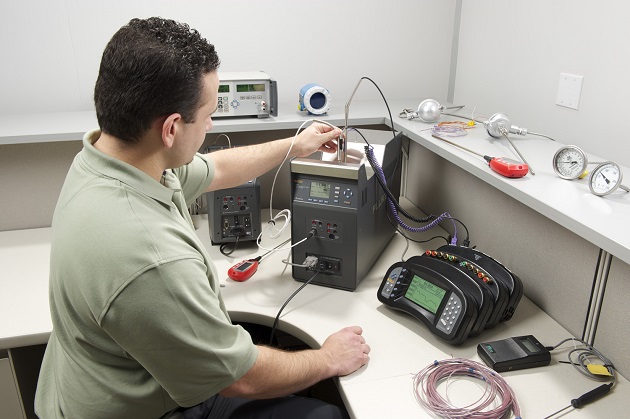- Otras empresas de Fluke:
- Fluke
- Fluke Biomedical
- Fluke Networks
- Fluke Process Instruments
How to calibrate a thermocouple
Thermocouples are common in industry because they are inexpensive and cover a wide temperature range. They should be tested during commissioning and again when removed from a process to verify that the tolerances were met. You’ll also want to test thermocouples at regular calibration intervals and if you suspect them of failing to meet performance specifications.
Because of their unique characteristics, it’s best to calibrate thermocouples in situ (in place) by comparison to a temperature standard. If that isn’t practical, remove the thermocouple and place it in a precision temperature source such as a dry-well calibrator.

To calibrate a thermocouple, follow these steps:
- Isolate the sensor (thermocouple) from the process.
- Immerse the sensor fully into a dry-well or bath that can cover the required temperature range.
- Disconnect the thermocouple from the electronics if you want to check the calibration separately from the control system temperature indicator.
- Connect the thermocouple to a precision instrument capable of measuring millivolts. Some dry-wells have the required electronics built in; alternately you could use a thermometer readout.
- Does the thermocouple have a reference junction? If it does not, ensure that the precision voltage measurement device has reference junction compensation turned on. This may be identified as RJC or CJC. If the thermocouple does have a reference junction, ensure that it is also immersed at the required reference temperature. Usually, this is 0 °C.
- Adjust the temperature of the bath or dry-well to each of the test points.
- At each test point, record the readings of the temperature standard and thermocouple.
- If you are measuring the thermocouple separately from its measurement electronics, compare the measured voltage to the expected voltage from the applicable temperature table. Otherwise, compare the reading on the instrument display to the reading of the temperature standard.
Want to learn more about calibrating thermocouples? Check out our Thermocouple Application Note Series for more in-depth information.
- Inicie sesión o regístrese para enviar comentarios
- Printer-friendly version »
- Inicio
- Productos
- Novedades de Fluke Calibration
- Calibración eléctrica
- Calibración de radiofrecuencia
- Equipo de adquisición de datos y pruebas
- Calibración de temperatura
- Calibración de humedad
- Calibración de presión
- Manómetros de pistón
- Controladores/Calibradores
- Monitores de presión
- Balanzas de pesos muertos
- Monitores y calibradores manuales
- Handheld Pressure Calibrators
- Calibración de datos de aire
- Monitores ambientales
- Accesorios de calibración de presión
- Sistemas personalizados de calibración de presión
- Software de calibración de presión
- Calibración de flujo
- Calibradores de procesos
- Software de calibración
- Servicio y soporte técnico
- Todos los instrumentos de calibración
- Instrumentos portátiles
- Comprar
- Novedades
- Capacitación y eventos
- Literatura y educación
- Soporte Técnico
- Service Request (RMA)
- Programas de servicio
- Servicio técnico
- Base de Conocimientos
- Acreditaciones
- Centros de servicio autorizados
- Calibration Certificates
- Community Forum
- My MET/SUPPORT
- Manuales de productos (guías de usuario)
- Hojas de datos sobre la seguridad (SDS)
- Programa de reciclado
- Safety, Service, and Product Notices
- Descargas de software
- Garantias
- Sobre Nosotros



